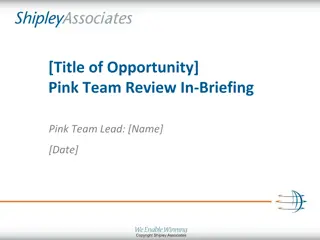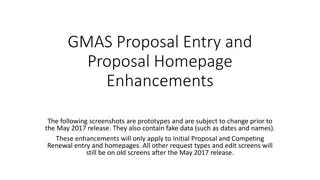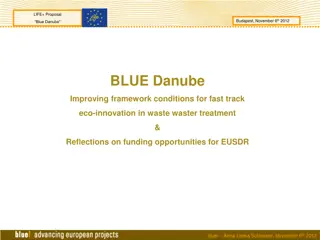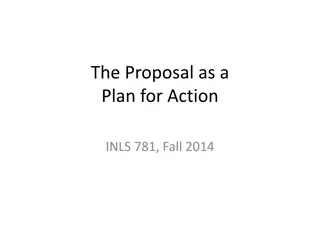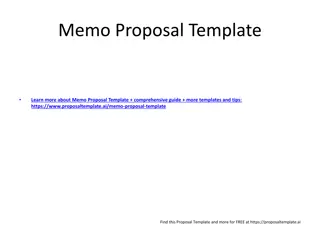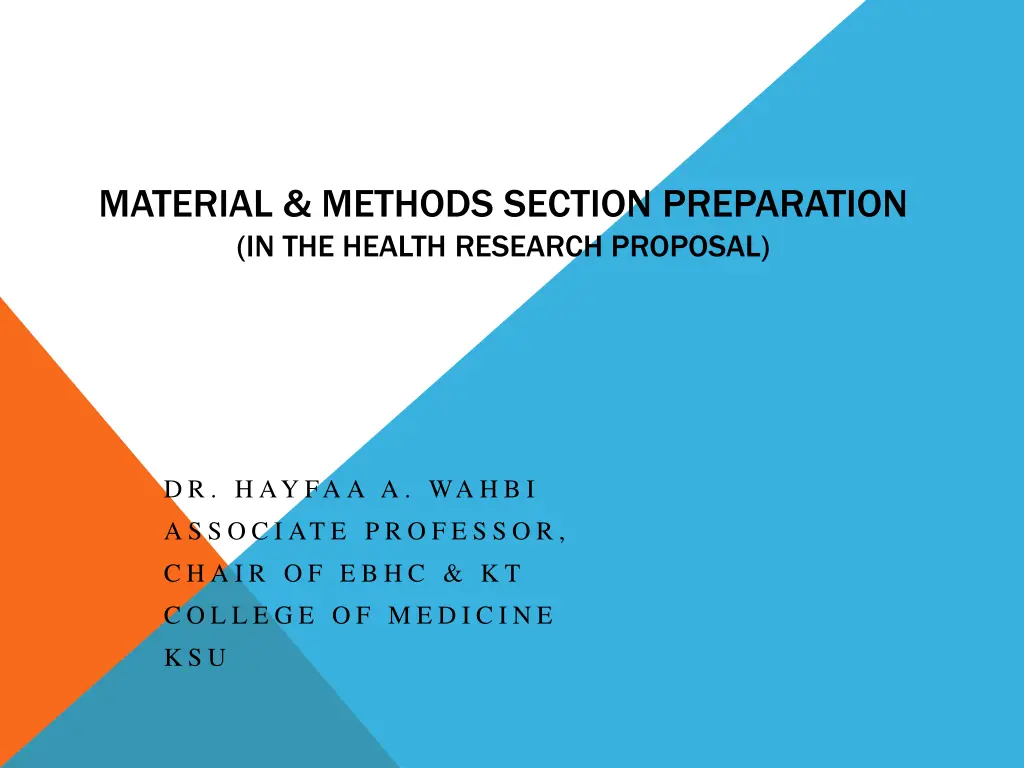
Effective Preparation of Material and Methods Section in Health Research Proposals
Creating a well-structured Material and Methods section is crucial in health research proposals. This section should directly address study questions, objectives, and hypotheses, while also emphasizing ethical considerations. Components such as study design, data collection tools, and data management must be clearly outlined for a successful proposal.
Uploaded on | 0 Views
Download Presentation

Please find below an Image/Link to download the presentation.
The content on the website is provided AS IS for your information and personal use only. It may not be sold, licensed, or shared on other websites without obtaining consent from the author. If you encounter any issues during the download, it is possible that the publisher has removed the file from their server.
You are allowed to download the files provided on this website for personal or commercial use, subject to the condition that they are used lawfully. All files are the property of their respective owners.
The content on the website is provided AS IS for your information and personal use only. It may not be sold, licensed, or shared on other websites without obtaining consent from the author.
E N D
Presentation Transcript
MATERIAL & METHODS SECTION PREPARATION (IN THE HEALTH RESEARCH PROPOSAL) D R . H AY FA A A . WA H B I A S S O C I AT E P R O F E S S O R , C H A I R O F E B H C & K T C O L L E G E O F M E D I C I N E K S U
QUESTIONS What are the components of a research proposal What are the components of the Material & Methods section Ethical considerations 2 M & M D E V E L O P M E NT
The M&M section should be directly related to the study question(s), objectives, hypotheses. It should be clear, informative, answers all 3 questions. Should clearly observe ethical considerations requested by all reviewers of research proposals / funding agencies 3 M & M D E V E L O P M E NT
PROPOSAL COMPONENTS Executive Summary Literature review & rationale Objectives & hypothesis Material & Methods Ethical considerations Timeline (chronogram) Budget References Investigating team M & M D E V E L O P M E NT
COMPONENTS OF M&M SECTION Study design Study setting Sampling Tools of data collection Data management and analysis Ethical considerations Pilot study 5 M & M D E V E L O P M E NT
MATERIAL AND METHOD SECTION An informative material & methods should answer the following questions: How is the study designed ? How will the study be carried out ? How will the data be analyzed ? M & M D E V E L O P M E NT
EXAMPLES 7 M & M D E V E L O P M E NT
8 M & M D E V E L O P M E NT
We will use a retrospective cohort study design to quantify the effects of maternal exposure to second-hand smoke on the neonatal anthropometric measurements. Each consecutive women who delivered in King Khalid University Hospital, meets the inclusion criteria and consents to the study will be included. 9 M & M D E V E L O P M E NT
COMPONENTS OF M&M SECTION Study design Study setting Sampling Tools of data collection Data management and analysis Ethical considerations Pilot study 10 M & M D E V E L O P M E NT
Sampling Plan: Sample size estimation Sampling technique (random, purposive) Sample selection (related details) Inclusion / exclusion criteria 11 M & M D E V E L O P M E NT
12 M & M D E V E L O P M E NT
After reviewing the literature, the sample size is based on an expected minimal difference of 30 g of birth weight between infants of women exposed and unexposed to SHS; the birth weight of Saudi newborn was reported to be around 3.100- 3.200 kg. At 95% significance level ( =5%) and a power of 80% ( =20%), the minimal sample size required to reject the null hypothesis was 2782 for both groups. To account for missing data the study will conducted over 12 months 13 M & M D E V E L O P M E NT
The inclusion criteria for this study will be: 1. Women with singleton pregnancy. 2. Term delivery ( 37 gestation week counted from the last menstrual period and/or early ultra-sound scan). 3. Women who did not smoke during the index pregnancy and were exposed to SHS (study group). 4. Women who did not smoke during the index pregnancy and were not exposed to SHS (control group). The exclusion criteria will be: We will exclude from this study women with unknown smoking status. 14 M & M D E V E L O P M E NT
COMPONENTS OF M&M SECTION Study design Study setting Sampling Tools of data collection Data management and analysis Ethical considerations Pilot study 15 M & M D E V E L O P M E NT
Data collection methods: Form [questionnaire/ case report form] Measurements [e.g. biometric / anthropometric] Laboratory investigations [types, referenced techniques / kits for each] 16 M & M D E V E L O P M E NT
17 M & M D E V E L O P M E NT
Data on SHS exposure will be collected by self-administered questionnaire, data on the maternal demographic characteristics and obstetric performance will be collected from maternal medical records and data for the neonatal anthropometric measurements which are measured by the attending midwife will be collected from the delivery records. The study will be carried out for 12 months 18 M & M D E V E L O P M E NT
The BMI will be calculated for each subject using the maternal weight and height which will be recorded during the booking visit, according to the following equation; BMI=weight (kg) / height (m) 2. The diagnosis of gestational diabetes will be based on the results of 75g oral glucose tolerance test (OGTT) done between 24-32 weeks gestation and requires that two or more of the venous plasma glucose concentrations exceed the following: fasting, 5.3mmol/l (95 mg/dl), one hour, 10.0mmol/l (180 mg/dl), two hours, 8.6mmol/l (155 mg/dl) and three hours, 7.8mmol/l (140 mg/dl). 20 M & M D E V E L O P M E NT
COMPONENTS OF M&M SECTION Study design Study setting Sampling Tools of data collection Data management and analysis Ethical considerations Pilot study 21 M & M D E V E L O P M E NT
Plan for statistical techniques and methods to be used Descriptive Analytical as related to study objectives / expected outcomes 22 M & M D E V E L O P M E NT
23 M & M D E V E L O P M E NT
Statistical analysis Statistical analyses will be performed using SPSS, version 18.0 (SPSS Inc., Chicago, IL, USA). Descriptive statistics will be computed for non-smoking pregnant women exposed and unexposed to SHS. Univariate analyses will be performed to compare the birth weight, infant s length and head circumference between the two groups as well as to evaluate the baseline characteristics between the groups which we considered as confounding factors. Chi-squared will be used to compare dichotomous outcomes and Student s t- test will be used to compare continuous outcomes. Stepwise logistic regression models will be used to adjust for potential confounders including maternal age, parity, BMI, GDM and gestational age (37 42 weeks). P value of < 0.05 will be considered statistically significant. 24 M & M D E V E L O P M E NT
25 M & M D E V E L O P M E NT
RESEARCH ETHICS Human participation in research projects has contributed to better quality of life through the development of diagnostic tools and successful treatments. Fundamental ethics need to be included in the design, implementation and evaluation phases of research, especially when involving human subjects. Such principles are universally agreed upon, and transcend cultural, geographical, economic, legal and political boundaries. 26 E TH I C S I N H R
EXPECTATIONS OF ETHICAL CONSIDERATIONS Design of a bilingual consent form (for written approval of participants) Assurance of respect of human rights in research involving human subjects, including: 1. Benefits outweigh risks 2. Confidentiality 3. Anonymity 4. Voluntary participation 27 M & M D E V E L O P M E NT
COMPONENTS OF M&M SECTION Study design Study setting Sampling Tools of data collection Data management and analysis Ethical considerations Pilot study 28 M & M D E V E L O P M E NT
The Pilot Study Purpose of the pilot study: 1. Estimate the sample size ..???? 2. Examine the logistics 3. Test the questionnaire administration 4. Test reliability and validity of the survey ???? 29 M & M D E V E L O P M E NT
Pilot studies should have a well-defined set of aims and objectives to ensure methodological rigor and scientific validity. Participants pilot study should not later be included in the main study The analysis of a pilot study should be mainly descriptive or should focus on confidence interval estimation. 30 M & M D E V E L O P M E NT
Results from hypothesis testing should be treated as preliminary and interpreted with caution, as no formal power calculations have been carried out. The temptation not to proceed with the main study when significant differences are found should be avoided. 31 M & M D E V E L O P M E NT
Important ..Before you Start your Proposal . 32 M & M D E V E L O P M E NT
You Have to Read Many Studies Addressing the Same Research Q 33 M & M D E V E L O P M E NT
34 M & M D E V E L O P M E NT


